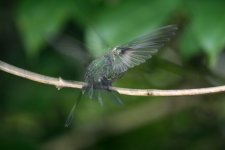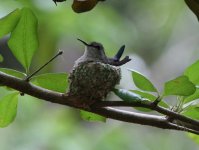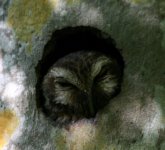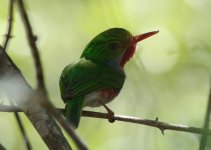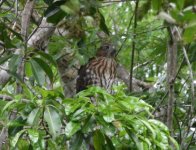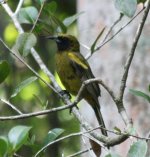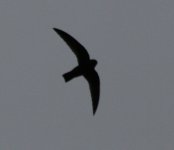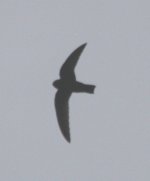Arbu
Well-known member
I have a list of places in the World I would like to visit, and to be honest, Cuba was never on it (!), but a £100 flight on eBay with Virgin to Havana was enough to tempt me into making a trip. So here’s a quick trip report. I did not have time to buy a dedicated field guide before I left so my Ids below are just made with A Photographic Guide to the Birds of the West Indies by New Holland, Sibley’s Field Guide to the Birds of Eastern North America, and the Wikipedia page on the Birds of Cuba http://en.wikipedia.org/wiki/List_of_birds_of_Cuba. If anything looks wrong, or you are able to help with any of my questions below, then I’d be pleased to hear from you.
13th May. A number of swifts flying around the Castillo de la Fuerza in Havana looked very much to be Chimney Swifts. The Wikipedia page says that these are only accidental but they seemed to fit this ID.
14th May. Driving to Playa Larga. Nothing remarkable except the only Osprey of the trip at La Boca and a Black Hawk on the beach near Playa Larga.
15th May. Out with the bird guide Angel near Soplillar. Cuban Tody, Cuban Trogon, Cuban Pygmy Owl, Cuban Screech-Owl, a Northern Waterthrush, and, best of all, a Blue-headed Quail-Dove on the path.
16th May. Driving out past the abandoned rice fields north-east of Playa Larga in the early evening. Lots of Northern Jacana, a Black-crowned Night Heron, a Limpkin, and lots of blackbirds with red on their wings. Would these have been Red-Shouldered or Red-Winged? Wikipedia says that both occur and that the former is endangered, but I’m not sure what the difference is and to me they seemed to be quite common. Also about a dozen whistling ducks flying over. Again Wikipedia leaves me wondering if these were more likely to have been West Indian or Fulvous? The photographic guide only mentions West Indian so at the time I assumed that this is what they were.
Heard a Stygian Owl in the hotel grounds at 10pm, but couldn’t see it.
17th May. Out with Angel again north of La Boca, into the marshes. We failed to find the Zapata Wren, but saw two Zapata Sparrows and a Cuban Pewee. Then across to some disused fields east of the road to Playa Larga where we saw both Fernandina’s and Northern Flickers and Cuban Parrot. Then down to near Soplillar where Angel showed me a female Bee Hummingbird on its nest and a juvenile Gundlach’s Hawk.
Afternoon walk on my own, where I finally found some Western Stripe-headed Tanagers, and got two more sightings of Gundlach’s Hawks.
18th May. Drive to Trinidad, seeing Red-tailed Hawk and Bobwhite on the way.
19th May. Boat ride to Cayo Blanco south of Trinidad. Not many seabirds, but on the Cay were two female American Redstarts, a Bahamas Mockingbird, and a Wilson’s Plover.
20th May. What I think were Cave Swallows were flying around the Museo Historico in Trinidad. But one or two of them seemed to have very white backs. Is this correct for Cave Swallows? Or maybe they just had a bit of albinism.
An afternoon walk in the Topes de Collantes produced a Ruddy Ground-Dove and some swifts that I had trouble identifying. There’s a photo attached below. They seemed almost completely plain, with, at times, slightly forked tails. Could they have been Black Swifts? I certainly couldn’t make out any white collars, so the only other possibility from the Wikipedia page would be Black Swift.
21st May. Around Yaguanabo. Pairs of each of Cuban Parrot and Cuban Crow at Yaguanabo Arriba. In the evening, at the shrimp ponds, lots of Antillean Nighthawks, a Grey Plover, a Turnstone, a Semipalmated Plover and a very small wader which I think was a Least Sandpiper. I couldn’t see the colour of the legs as the light was poor, but the bill didn’t look right for Semipalmated or Western Sandpiper.
22nd May. A Crested Caracara by the road near Cienfuegos. An afternoon visit to the Rio Hatiguanico produced a number of Orioles which I assume must have been juvenile Black-cowled Orioles, although they looked pretty different from the adults I had seen previously (photo attached). Also another Fernandina’s Flicker.
23rd May. A number of Antillean Palm Swifts around the Castillo El Morro in Havana.
Here’s a provisional list:
Northern Bobwhite
West Indian Whistling-duck
Wood Stork
White Ibis
Glossy Ibis
Black-crowned Night-heron
Green Heron
Cattle Egret
Great Blue Heron
Great Egret
Little Blue Heron
Magnificent Frigatebird
Brown Pelican
Double-crested Cormorant
Great Cormorant
Anhinga
Turkey Vulture
Crested Caracara
American Kestrel
Osprey
Gundlach's Hawk
Cuban Black Hawk
Red-tailed Hawk
Common Moorhen
Limpkin
Black-necked Stilt
Grey Plover
Semipalmated Plover
Wilson's Plover
Killdeer
Northern Jacana
Spotted Sandpiper
Ruddy Turnstone
Least Sandpiper
Laughing Gull
Gull-billed Tern
Royal Tern
Sandwich Tern
Sooty Tern
Rock Pigeon
White-crowned Pigeon
Scaly-naped Pigeon
Eurasian Collared-dove
Mourning Dove
Zenaida Dove
White-winged Dove
Common Ground-dove
Ruddy Quail-dove
Blue-headed Quail-dove
Cuban Amazon
Great Lizard-cuckoo
Smooth-billed Ani
Bare-legged Owl
Stygian Owl
Antillean Nighthawk
American Black Swift
Chimney Swift
Antillean Palm-swift
Cuban Emerald
Bee Hummingbird
Cuban Trogon
Cuban Tody
West Indian Woodpecker
Cuban Green Woodpecker
Northern Flicker
Fernandina's Flicker
Greater Antillean Pewee
Grey Kingbird
Loggerhead Kingbird
La Sagra's Flycatcher
Cuban Vireo
Black-whiskered Vireo
Cuban Crow
Cuban Martin
Cave Swallow
Northern Mockingbird
Bahama Mockingbird
Red-legged Thrush
House Sparrow
Yellow Warbler
American Redstart
Northern Waterthrush
Yellow-headed Warbler
Black-cowled Oriole
Shiny Cowbird
Cuban Blackbird
Red-shouldered Blackbird
Tawny-shouldered Blackbird
Greater Antillean Grackle
Eastern Meadowlark
Cuban Sparrow
Cuban Bullfinch
Yellow-faced Grassquit
Western Spindalis
13th May. A number of swifts flying around the Castillo de la Fuerza in Havana looked very much to be Chimney Swifts. The Wikipedia page says that these are only accidental but they seemed to fit this ID.
14th May. Driving to Playa Larga. Nothing remarkable except the only Osprey of the trip at La Boca and a Black Hawk on the beach near Playa Larga.
15th May. Out with the bird guide Angel near Soplillar. Cuban Tody, Cuban Trogon, Cuban Pygmy Owl, Cuban Screech-Owl, a Northern Waterthrush, and, best of all, a Blue-headed Quail-Dove on the path.
16th May. Driving out past the abandoned rice fields north-east of Playa Larga in the early evening. Lots of Northern Jacana, a Black-crowned Night Heron, a Limpkin, and lots of blackbirds with red on their wings. Would these have been Red-Shouldered or Red-Winged? Wikipedia says that both occur and that the former is endangered, but I’m not sure what the difference is and to me they seemed to be quite common. Also about a dozen whistling ducks flying over. Again Wikipedia leaves me wondering if these were more likely to have been West Indian or Fulvous? The photographic guide only mentions West Indian so at the time I assumed that this is what they were.
Heard a Stygian Owl in the hotel grounds at 10pm, but couldn’t see it.
17th May. Out with Angel again north of La Boca, into the marshes. We failed to find the Zapata Wren, but saw two Zapata Sparrows and a Cuban Pewee. Then across to some disused fields east of the road to Playa Larga where we saw both Fernandina’s and Northern Flickers and Cuban Parrot. Then down to near Soplillar where Angel showed me a female Bee Hummingbird on its nest and a juvenile Gundlach’s Hawk.
Afternoon walk on my own, where I finally found some Western Stripe-headed Tanagers, and got two more sightings of Gundlach’s Hawks.
18th May. Drive to Trinidad, seeing Red-tailed Hawk and Bobwhite on the way.
19th May. Boat ride to Cayo Blanco south of Trinidad. Not many seabirds, but on the Cay were two female American Redstarts, a Bahamas Mockingbird, and a Wilson’s Plover.
20th May. What I think were Cave Swallows were flying around the Museo Historico in Trinidad. But one or two of them seemed to have very white backs. Is this correct for Cave Swallows? Or maybe they just had a bit of albinism.
An afternoon walk in the Topes de Collantes produced a Ruddy Ground-Dove and some swifts that I had trouble identifying. There’s a photo attached below. They seemed almost completely plain, with, at times, slightly forked tails. Could they have been Black Swifts? I certainly couldn’t make out any white collars, so the only other possibility from the Wikipedia page would be Black Swift.
21st May. Around Yaguanabo. Pairs of each of Cuban Parrot and Cuban Crow at Yaguanabo Arriba. In the evening, at the shrimp ponds, lots of Antillean Nighthawks, a Grey Plover, a Turnstone, a Semipalmated Plover and a very small wader which I think was a Least Sandpiper. I couldn’t see the colour of the legs as the light was poor, but the bill didn’t look right for Semipalmated or Western Sandpiper.
22nd May. A Crested Caracara by the road near Cienfuegos. An afternoon visit to the Rio Hatiguanico produced a number of Orioles which I assume must have been juvenile Black-cowled Orioles, although they looked pretty different from the adults I had seen previously (photo attached). Also another Fernandina’s Flicker.
23rd May. A number of Antillean Palm Swifts around the Castillo El Morro in Havana.
Here’s a provisional list:
Northern Bobwhite
West Indian Whistling-duck
Wood Stork
White Ibis
Glossy Ibis
Black-crowned Night-heron
Green Heron
Cattle Egret
Great Blue Heron
Great Egret
Little Blue Heron
Magnificent Frigatebird
Brown Pelican
Double-crested Cormorant
Great Cormorant
Anhinga
Turkey Vulture
Crested Caracara
American Kestrel
Osprey
Gundlach's Hawk
Cuban Black Hawk
Red-tailed Hawk
Common Moorhen
Limpkin
Black-necked Stilt
Grey Plover
Semipalmated Plover
Wilson's Plover
Killdeer
Northern Jacana
Spotted Sandpiper
Ruddy Turnstone
Least Sandpiper
Laughing Gull
Gull-billed Tern
Royal Tern
Sandwich Tern
Sooty Tern
Rock Pigeon
White-crowned Pigeon
Scaly-naped Pigeon
Eurasian Collared-dove
Mourning Dove
Zenaida Dove
White-winged Dove
Common Ground-dove
Ruddy Quail-dove
Blue-headed Quail-dove
Cuban Amazon
Great Lizard-cuckoo
Smooth-billed Ani
Bare-legged Owl
Stygian Owl
Antillean Nighthawk
American Black Swift
Chimney Swift
Antillean Palm-swift
Cuban Emerald
Bee Hummingbird
Cuban Trogon
Cuban Tody
West Indian Woodpecker
Cuban Green Woodpecker
Northern Flicker
Fernandina's Flicker
Greater Antillean Pewee
Grey Kingbird
Loggerhead Kingbird
La Sagra's Flycatcher
Cuban Vireo
Black-whiskered Vireo
Cuban Crow
Cuban Martin
Cave Swallow
Northern Mockingbird
Bahama Mockingbird
Red-legged Thrush
House Sparrow
Yellow Warbler
American Redstart
Northern Waterthrush
Yellow-headed Warbler
Black-cowled Oriole
Shiny Cowbird
Cuban Blackbird
Red-shouldered Blackbird
Tawny-shouldered Blackbird
Greater Antillean Grackle
Eastern Meadowlark
Cuban Sparrow
Cuban Bullfinch
Yellow-faced Grassquit
Western Spindalis




